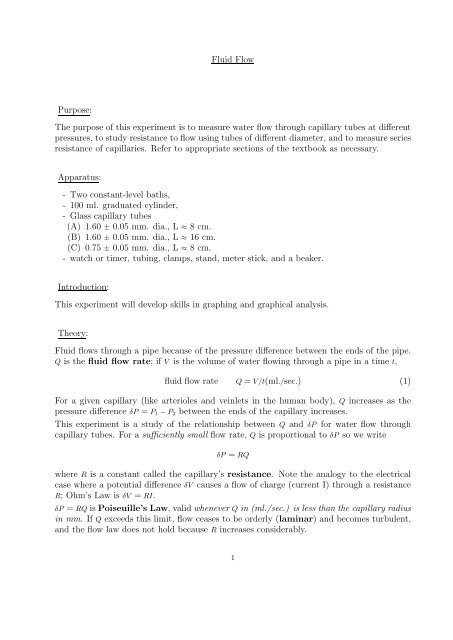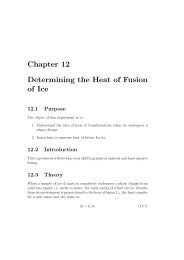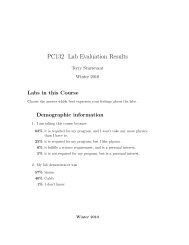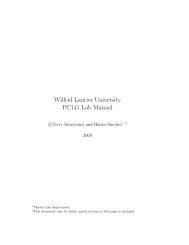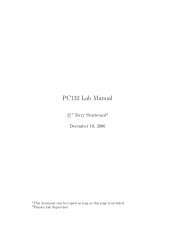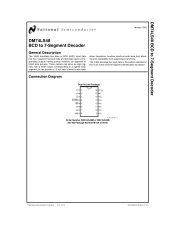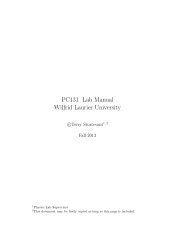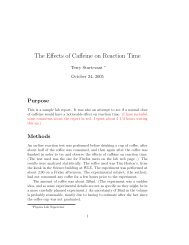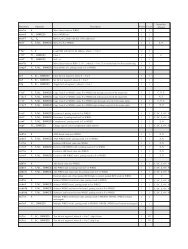Fluid Flow Purpose: The purpose of this experiment is to measure ...
Fluid Flow Purpose: The purpose of this experiment is to measure ...
Fluid Flow Purpose: The purpose of this experiment is to measure ...
Create successful ePaper yourself
Turn your PDF publications into a flip-book with our unique Google optimized e-Paper software.
<strong>Fluid</strong> <strong>Flow</strong><br />
<strong>Purpose</strong>:<br />
<strong>The</strong> <strong>purpose</strong> <strong>of</strong> <strong>th<strong>is</strong></strong> <strong>experiment</strong> <strong>is</strong> <strong>to</strong> <strong>measure</strong> water flow through capillary tubes at different<br />
pressures, <strong>to</strong> study res<strong>is</strong>tance <strong>to</strong> flow using tubes <strong>of</strong> different diameter, and <strong>to</strong> <strong>measure</strong> series<br />
res<strong>is</strong>tance <strong>of</strong> capillaries. Refer <strong>to</strong> appropriate sections <strong>of</strong> the textbook as necessary.<br />
Apparatus:<br />
- Two constant-level baths,<br />
- 100 ml. graduated cylinder,<br />
- Glass capillary tubes<br />
(A) 1.60 ± 0.05 mm. dia., L ≈ 8 cm.<br />
(B) 1.60 ± 0.05 mm. dia., L ≈ 16 cm.<br />
(C) 0.75 ± 0.05 mm. dia., L ≈ 8 cm.<br />
- watch or timer, tubing, clamps, stand, meter stick, and a beaker.<br />
Introduction:<br />
Th<strong>is</strong> <strong>experiment</strong> will develop skills in graphing and graphical analys<strong>is</strong>.<br />
<strong>The</strong>ory:<br />
<strong>Fluid</strong> flows through a pipe because <strong>of</strong> the pressure difference between the ends <strong>of</strong> the pipe.<br />
Q <strong>is</strong> the fluid flow rate; if V <strong>is</strong> the volume <strong>of</strong> water flowing through a pipe in a time t,<br />
fluid flow rate Q = V/t(ml./sec.) (1)<br />
For a given capillary (like arterioles and veinlets in the human body), Q increases as the<br />
pressure difference δP = P 1 − P 2 between the ends <strong>of</strong> the capillary increases.<br />
Th<strong>is</strong> <strong>experiment</strong> <strong>is</strong> a study <strong>of</strong> the relationship between Q and δP for water flow through<br />
capillary tubes. For a sufficiently small flow rate, Q <strong>is</strong> proportional <strong>to</strong> δP so we write<br />
δP = RQ<br />
where R <strong>is</strong> a constant called the capillary’s res<strong>is</strong>tance. Note the analogy <strong>to</strong> the electrical<br />
case where a potential difference δV causes a flow <strong>of</strong> charge (current I) through a res<strong>is</strong>tance<br />
R; Ohm’s Law <strong>is</strong> δV = RI.<br />
δP = RQ <strong>is</strong> Po<strong>is</strong>euille’s Law, valid whenever Q in (ml./sec.) <strong>is</strong> less than the capillary radius<br />
in mm. If Q exceeds <strong>th<strong>is</strong></strong> limit, flow ceases <strong>to</strong> be orderly (laminar) and becomes turbulent,<br />
and the flow law does not hold because R increases considerably.<br />
1
<strong>Fluid</strong> <strong>Flow</strong><br />
Res<strong>is</strong>tance depends upon the fluid v<strong>is</strong>cosity η and the capillary length L and radius r and<br />
for laminar flow,<br />
R = 8ηL<br />
πr 4 (2)<br />
i. e.: R ∝ L; R ∝ 1/r 4 . Thus, if L <strong>is</strong> doubled, R <strong>is</strong> doubled: if r <strong>is</strong> doubled, R <strong>is</strong> decreased by<br />
1/16. Consequently, small radius changes will cause relatively large changes in res<strong>is</strong>tance,<br />
and thus also in flow for a given pressure difference.<br />
Don’t confuse R and r in <strong>th<strong>is</strong></strong> <strong>experiment</strong>!<br />
¡¢£¤¥<br />
¦§¨©<br />
<br />
<br />
Figure 1<br />
Procedure:<br />
<strong>The</strong> capillary tube <strong>is</strong> connected by rubber tubes <strong>to</strong> the drain outlets <strong>of</strong> two constant–<br />
level baths as in Fig. 1. With baths at different heights there <strong>is</strong> a pressure difference related<br />
<strong>to</strong> the difference in height (or “head”) δh = h 1 − h 2 <strong>of</strong> the upper–surface levels <strong>of</strong> the two<br />
baths by the relationship<br />
δP = ρgδh<br />
where<br />
ρ = 1000kg/m 3<br />
for water,<br />
g = 9.8m/sec 2<br />
and<br />
1 cc = 1 ml = 10 −6 m 3<br />
2
<strong>Fluid</strong> <strong>Flow</strong><br />
Constant–level baths maintain their upper surface level constant by means <strong>of</strong> continuous<br />
input and an overflow pipe. Side 1 <strong>is</strong> the upper level bath, side 2 <strong>is</strong> the lower level bath.<br />
Capillary tubes must be mounted horizontally and water must flow from the tap continuously<br />
and drain <strong>to</strong> the sink continuously. With clamp 2 on, fill bath 2 using a graduated<br />
cylinder up <strong>to</strong> the overflow drain: <strong>th<strong>is</strong></strong> <strong>is</strong> where the flow volume V will be collected. Place a<br />
graduated cylinder under <strong>th<strong>is</strong></strong> drain via the drain-tube, open clamp 2 and get a continuous<br />
flow <strong>of</strong> water in<strong>to</strong> the collecting graduated cylinder by making δh at least several cm. Try<br />
<strong>to</strong> exclude all bubbles from the tubing by pinching tubes at appropriate positions. Try <strong>to</strong><br />
ensure that <strong>th<strong>is</strong></strong> flow <strong>is</strong> continuous for a few minutes, draining the graduated cylinder as<br />
required.<br />
Exerc<strong>is</strong>e 1: Capillary Res<strong>is</strong>tance<br />
Use capillary tube A first, and get the apparatus running smoothly as described previously.<br />
Set δh <strong>to</strong> 20 cm. and again get the system running smoothly by letting flow occur<br />
for a couple <strong>of</strong> minutes. Drain the graduated cylinder without interrupting water flow (use<br />
a beaker <strong>to</strong> catch flow while draining cylinder), replace it under flow, and record the time<br />
<strong>to</strong> the nearest second as water level passes the 15 ml. mark on the cylinder. Record the<br />
time again as the collected water level passes the 25 ml. mark. <strong>The</strong>se collected volumes and<br />
times should be entered in an appropriate table.<br />
If using a s<strong>to</strong>pwatch, the “lap” or ‘split” feature <strong>is</strong> useful here. <strong>The</strong> reason for<br />
starting the volume at something other than zero <strong>is</strong> that it reduces errors due <strong>to</strong> “getting<br />
started”;ie. you can anticipate the events you are timing, so your reaction time should not<br />
play as big a part.<br />
Still using tube A, repeat <strong>measure</strong>ments with δh = 15, 10, and 5 cm. successively; it <strong>is</strong><br />
important <strong>to</strong> start with highest pressure head first and ”work” downward, having got smooth<br />
flow and bubble-free tubing at higher rates first.<br />
Note: If water being collected splashes in<strong>to</strong> graduated cylinder the level readings are<br />
hard <strong>to</strong> make, thus, let the drops flow down the side <strong>of</strong> the graduated cylinder by<br />
<strong>to</strong>uching the flow tubing <strong>to</strong> the inside wall <strong>of</strong> the graduated cylinder near the <strong>to</strong>p.<br />
Repeat these <strong>measure</strong>ments for tubes B and C, and use clamps 1 and 2 while making the<br />
change <strong>of</strong> capillary tubing.<br />
For each tube one must be careful not <strong>to</strong> exceed the limiting case for laminar flow, hence<br />
the maximum δh <strong>is</strong> important.<br />
For tube B, use δh roughly 15, 12, 9, and 6 cm.<br />
For tube C, use δh roughly 18, 15, 12, and 9 cm.<br />
Please do not alter tube connections <strong>to</strong> constant level baths as they are quite delicate.<br />
Capillary diameters are given; <strong>measure</strong> lengths L with a meter stick.<br />
What <strong>is</strong> the real<strong>is</strong>tic uncertainty in the length <strong>of</strong> the tubes, based on how cleanly the ends<br />
are cut Be sure <strong>to</strong> use <strong>th<strong>is</strong></strong> value in your calculations.<br />
3
<strong>Fluid</strong> <strong>Flow</strong><br />
Proceed through the exerc<strong>is</strong>e and create a data table with entries for fluid flow and pressure<br />
head causing the flow. When the table <strong>is</strong> full, plot all the results as pressure δP vs. flow<br />
rate Q, with all data for all 3 tubes on the same graph sheet. (Is the origin a point) Draw<br />
a straight line through the data for each <strong>of</strong> the tubes.<br />
As δP = RQ, then R = δP/Q which <strong>is</strong> the slope <strong>of</strong> the graph. Find R by <strong>th<strong>is</strong></strong> graphical method<br />
for each <strong>of</strong> the capillary tubes. Does the y-intercept agree with what you expect Explain.<br />
As<br />
R = 8ηL<br />
πr 4 ,<br />
then r 4 R/L = 8η/π = constant (3)<br />
Hence, using R as obtained graphically, r 4 R/L <strong>is</strong> calculated for each <strong>of</strong> the tubes, and the<br />
average <strong>of</strong> these three values <strong>is</strong> obtained. From <strong>th<strong>is</strong></strong> average, the v<strong>is</strong>cosity <strong>of</strong> water at the<br />
<strong>to</strong>p temperature <strong>is</strong> obtained.<br />
Exerc<strong>is</strong>e 2: Res<strong>is</strong>tance <strong>of</strong> Capillaries in Series<br />
Connect capillary tubes A and B in “series” with a 2 inch piece <strong>of</strong> tubing. Ensure<br />
somehow that they lie horizontally on the same line. Measure Q for several values <strong>of</strong> δh and<br />
record in a table like that used in Ex. 1.<br />
Plot the pressure vs. flow results on the same graph as used in Ex. 1, and calculate the<br />
res<strong>is</strong>tance from the graph.<br />
<strong>The</strong> result R series should equal the sum <strong>of</strong> the separate res<strong>is</strong>tances:<br />
R series = R A + R B (4)<br />
Compare the result with the sum obtained from Ex. 1. (Note that <strong>th<strong>is</strong></strong> <strong>is</strong> also analogous <strong>to</strong><br />
what happens with res<strong>is</strong>tances in series in an electrical circuit.)<br />
4


